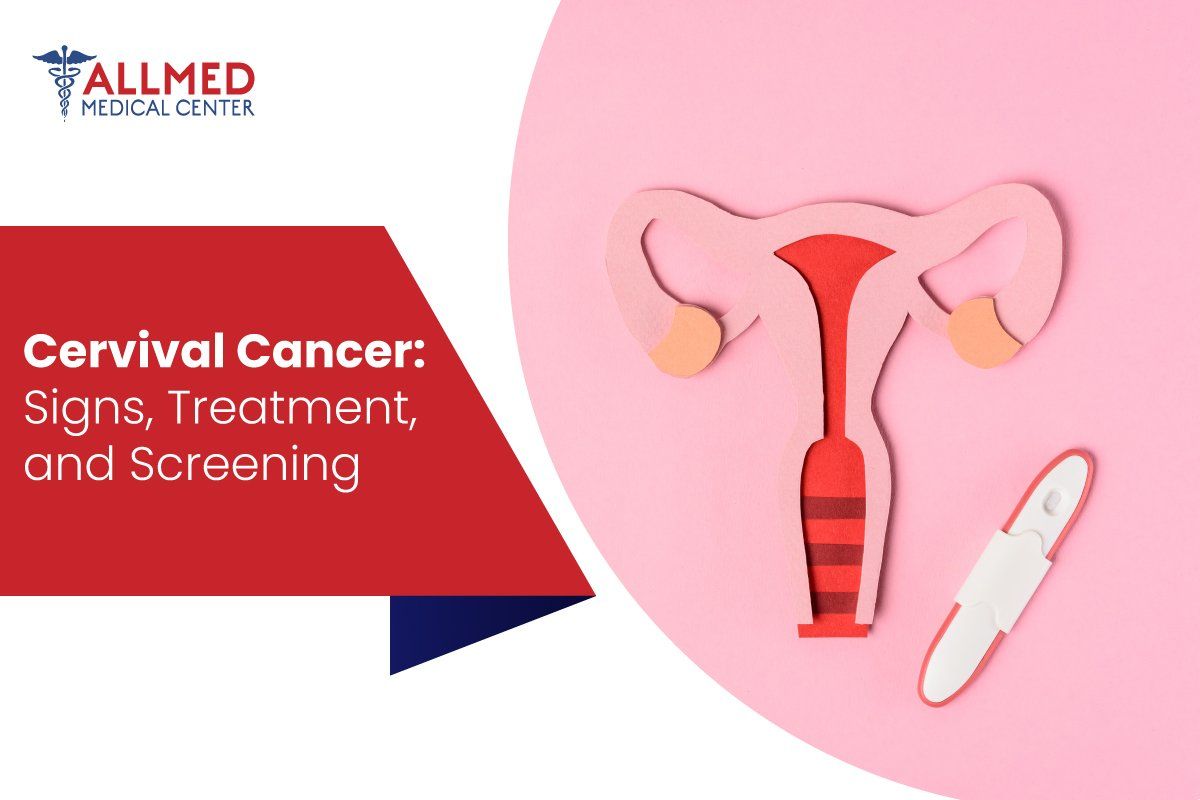
We Proudly Accept Medi-Cal and Medicare
Write your caption hereButton
Now Accepting Walk-ins!
Write your caption here

We Proudly Accept Medi-Cal and Medicare
Write your caption hereButton
Now Accepting Walk-ins!
Write your caption here

Cervical cancer is a life-threatening disease that affects women worldwide. Women above 30 are at risk of developing cervical cancer. However, it can happen to younger women as well. The symptoms range from bloody vaginal discharge to painful urination. Moreover, some of the worst cases are due to late detection.
This article will focus on the signs and symptoms of cervical cancer. In addition, we'll talk about the significance of screening and early detection. Recognizing the early signs of cervical cancer can prevent complications and save lives.
What is Cervical Cancer?
What does cervical cancer look like? These questions plague the minds of women worldwide. It can happen to women anytime, making it even more frightening than it already is. Fortunately, we have the answers for you. Let's begin with the definition.
Cervical Cancer
Cervical cancer is the proliferation of abnormal cells in the cervix. It typically develops due to prolonged human papillomavirus or HPV infection. Moreover, sexual contact is one of the most common causes of HPV transmission, eventually leading to cervical cancer.
Causes of Cervical Cancer
Chronic infections with certain types of human papillomavirus (HPV) cause cervical cancer. HPV is a common virus passed from one person to another during sex, 13 million Americans, including teens, become infected with HPV each year. Often, sexually active individuals will have HPV at some point. Still, only a small percentage of women will get cervical cancer.
Cancer and HPV Infection
Unfortunately, immunocompromised individuals (such as those with HIV) won't have a properly functioning immune system. Without a healthy functioning immune system, the body can’t fight infections. A lingering HPV infection that contains oncogenic HPV can change normal cells into abnormal cells. Without the body's immune system, it can't eliminate it. In approximately 10% of cases with HPV infections on the cervix, women with long-lasting HPV infections increase the risk of cervical cancer.
To learn more, read about
Cervical Cancer.
Is Cervical Cancer Serious?
Cervical cancer is very serious, it is critical to highlight the importance of screening for early detection. Cervical cancer has a 92% 5-year survival rate when detected early. However, only 44% of cervical cancer is diagnosed early. The 5-year survival rate drops to 58% when cancer has spread to nearby tissues, organs, and lymph nodes.
Risk Factors for Cervical Cancer
The following can increase your risk of developing cervical cancer:
- Being immunocompromised (such as HIV) or other conditions that make it hard for your body to fight infections.
- Chronic smoking.
- Long-term use of birth control pills
- Given birth to three or more children.
- Having multiple sex partners
Cervical Cancer Symptoms
Here are the common signs of cervical cancer we've compiled for your better understanding.
Symptoms of Cervical Cancer in the Early Stages
It is vital to detect cervical cancer early. The following symptoms should raise suspicion for cervical cancer:
- Vaginal bleeding after intercourse, between periods, or after menopause
- A foul-smelling or heavy vaginal discharge
- A feeling of pain during sexual activity
Complications
Aside from cervical cancer symptoms, you should also consider the complications. Advanced stages of cervical cancer can spread to nearby organs or tissues in your body.
Cervical cancer symptoms considered to be severe include the following:
- Pelvic or abdominal pain.
- LBM, or pain or bleeding in the rectum when you defecate
- Dull back pain or swelling in your legs
- Difficult or painful urination (sometimes with blood)
- Easy fatigability
- Loss of weight and appetite
How Is Cervical Cancer Diagnosed?
You will likely undergo a thorough examination of your cervix if cervical cancer is suspected. Checking for abnormal cells requires using a particular magnifying instrument (colposcope).
With colposcopic examination, the goal is to retrieve a sample of cervical cells. Your doctor may use the following methods to obtain tissue:
- A punch biopsy involves pinching off small cervical tissue samples with a sharp tool.
- Curettage of the cervix involves scraping a tissue sample from the cervix with a small spoon-shaped instrument (curet).
It may be necessary to perform the following tests if punch biopsy or endocervical curettage are concerning:
- Using a thin, low-voltage electric wire to obtain a small tissue sample. The procedure is usually performed under local anesthesia in the office.
- By performing a cone biopsy (conization), your doctor can obtain cervical cells from deeper layers for laboratory testing.
Staging
Further tests will determine the cancer's extent (stage) if a biopsy confirms cervical cancer. Choosing the right treatment depends on the staging.
Staging exams include:
- Imaging tests such as X-rays, CT, MRI, and positron emission tomography (PET) evaluate if cancer cells have spread beyond the cervix.
- Visual examination of your bladder and rectum.
How Is Cervical Cancer Treated?
If cervical cancer is confirmed through biopsy, there are treatment options that your doctor will recommend:
- Using radiation therapy. The energy beams used in radiation therapy kill cancer cells on the cervix.
- Treatment with chemotherapy. Chemotherapy treatment involves administering drugs to kill cancerous cells anywhere in the body. Chemotherapy is usually given in cycles.
- Surgical intervention. There are a variety of surgeries available for treating cervical cancer. One option is a simple hysterectomy. A simple hysterectomy removes the uterus and cervix to limit the spread of cancer cells to neighboring organs and tissues.
- Using targeted therapies. Targeted drug treatments destroy specific cancer cells without harming healthy cells.
- Treatment with immunotherapy. A medical treatment to stimulate the immune system to recognize and destroy cancer cells.
The Importance of Early Screening for Cervical Cancer
The importance of early detection of cervical cancer cannot be overstated. Cervical cancer symptoms usually develop at advanced stages, making screening for it crucial to your health.
Two screening tests can detect cervical cancer early. Among them are:
- Pap smears (or Pap tests) detect cell changes on the cervix that may develop into cervical cancer if untreated.
- HPV tests look for the virus that causes these changes.
You can get these tests from your doctor or clinic. Your doctor will widen your vagina with a plastic or metal instrument called a speculum. Doctors use this to examine the vagina and cervix and collect a few cells and mucus from around the cervix. A laboratory examines the cells.
- A Pap test checks to see if the cells look normal.
- An HPV test will test your cells for the presence of HPV.
When Should I Get Screened?
For cervical cancer screening, the American Cancer Society recommends the following:
For those aged 21 to 29
Pap tests should begin at age 21. In the case of a normal Pap test result, your doctor may tell you to wait three years before having another Pap test.
Note: According to new guidelines from the American Cancer Society, cervical cancer screening should begin at 25. For people aged 21 to 24, the benefits of cervical cancer screening do not outweigh the harm.
Between the ages of 30 and 65
- A Pap test. With normal pap test results, your doctor may advise you to wait three years before doing it again.
- HPV only. This is called primary HPV testing. After you receive a normal screening test result, your doctor may recommend waiting five years before you undergo another screening.
- Co-Testing. Depending on the results of both Pap and HPV test, your doctor might suggest that you delay your next screening for five years if both are normal.
For Age 65 and Above
If the following conditions apply to women in this age group, screening for cervical cancer may not be necessary:
- Your screening test results have been normal for seven years, or
- Fibroids or another type of non-cancerous condition necessitated a total hysterectomy.
Do People Benefit From More Testing?
Not at all. In the case of too many tests, they can cause more harm than good. Risks associated with cervical cancer screening include:
- Screening tests and follow-up tests often cause physical discomfort.
- False-positive test results can cause anxiety and other emotions.
- It's possible that you'll receive unnecessary tests or even incorrect treatments.
Early Screening Saves Lives
Cervical cancer can sneak behind you, presenting symptoms usually at its advanced stages. Early screening can give you a better chance of beating cervical cancer. If you are seeking “cervical cancer screening near me”, look no future. At All Med Medical Center, our clinic provides screening for cervical cancer, including a Pap test, HPV test, or co-testing. We value the importance of early screening for women's health.
Schedule an appointment with our hotline today. You can reach us by dialing 1-8333-255-6332. You can also look for your preferred clinic by clicking this link.
AllMed Medical CentersServing
Greater Sacramento
Allmed Medical Center | All Rights Reserved.










